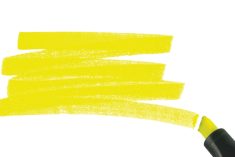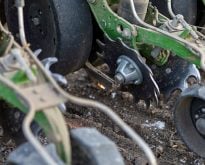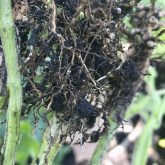Soybeans are now a regular crop in a Manitoba rotation, and since they use a lot of potassium, you’d think that it would make sense to provide them with enough to keep them happy. But a study funded by the Manitoba Pulse and Soybean Growers and Western Grains Research Foundation found little response to added K fertilizer, even on low-K testing soils.
Results of the study in 2017 and 2018 were recently published in the Canadian Journal of Plant Science by researchers Megan Bourns (formerly of MPSG) and Don Flaten of the University of Manitoba. On-farm, field-scale trials were established at various Manitoba sites to evaluate soybean yield response across a range of soil test K levels. Plot-scale trials determined the effect of different K fertilizer rates and placements for soybeans on low-K soils.
Soybean is a high user of potassium, removing more than most other crops in Western Canada. Current recommendations for soybeans in Manitoba are the same as for canola and wheat, but they do not remove anywhere near as much potassium. The Manitoba K rates and soil test thresholds are lower than those in other soybean-producing regions such as Ontario, North Dakota and Minnesota.
Read Also

Sensing the soil: Root cell research finds ‘stress hormone’
Research into how root cells react to soil stressors could help plants better adapt to changes in their climate.
[RELATED] Are your soybeans O-K?
Recommendation too high?
But the on-farm trials did not discover any relationship between soil test K levels and soybean yield, even on soils with levels lower than the current 100 parts per million recommended threshold. That led the study team to conclude that 100 ppm could be too high for soybeans in Manitoba and/or that the common ammonium acetate soil testing method for measuring exchangeable K might not be the best way for predicting soybean response to K.
For the time being, though, there is no alternative recommendation.
“Until further research is done to determine whether the current soil test threshold for recommending K fertilization is adequate, the recommendation is to follow current guidelines as described in the soil fertility guide,” Bourns says.

Even when there were visual mid-season symptoms of K deficiency, the researchers found there was still no yield response to K fertilizer at varying rates and placements.
K deficiency shows up as yellowing between the veins, while the veins stay green (interveinal chlorosis) on the margins of lower leaves in early-season soybeans.
“We first saw these symptoms around V2 to V3 in our plots,” says Bourns, who conducted the research as part of her master’s thesis. “Later in the season, during seed fill, similar symptoms may develop in the upper canopy, as K is translocated from leaves to seeds.”
For the on-farm trials, 20 site-years were established on fields with soil test K levels between 52 and 235 ppm. Each site had replicated strips comparing an untreated check to K fertilizer treatments of 60 pounds of K2O/ac. banded away from the seed, or 120 pounds K2O/ac. broadcast and incorporated.
Only three of the 20 sites had a significant yield response to the applied K fertilizer, with two sites showing a yield increase and one site a yield decrease. Of the two positive yield sites, just one had soil test K levels below the recommended 100 ppm threshold. The researchers found no definitive reasons for the significant yield differences at these three sites.
They had also expected to see a yield response to K fertilizer application in many of the low K sites, but did not, which has led them to conclude that soil test K below 100 ppm does not indicate additional K fertilizer will increase soybean yield.
No response despite symptoms
For the small plot trials, seven site-years were established on low-K sites with soil test K levels ranging from 49 to 117 ppm. Six treatments were compared: no K, side-banded K at 30 or 60 lbs. K2O/ac., and broadcast and incorporated K at 30, 60 or 120 lbs. K2O/ac. Potash (0-0-60) was used as the K fertilizer source.
In both years, symptoms of K deficiency began to show in the control plots early in the season (at V2-V3 stages). The plants seemed to grow out of the deficiency until growth stage R5 when K deficiency symptoms developed in the upper canopy. These symptoms appeared to confirm that the sites were indeed low in K. However, no statistically or agronomically significant yield responses were found for any of the treatments.
The researchers were surprised by the lack of yield response, particularly in the small plot studies.
“We had seen visual K deficiency symptoms clearly showing up in our zero-K control plots, both early in the season and later, during seed fill,” Bourns says. “Based on the visual differences, we certainly thought we would see yield response.”
Bourns says a few factors may have contributed to the lack of response.
“Growing season conditions are certainly a major factor, with moisture and temperature driving much of our soy- bean yield potential in Manitoba. The 2017 and 2018 growing seasons were dry where our trials were, and it could be the case that a lack of moisture was the main driver for yield. As a result, even low K concentrations were sufficient to meet soybean needs under those conditions.”
Despite the lack of rainfall, the soybeans averaged 31.6 bu./ac. over the two years (40 bu./ac. in 2017 and 23 bu./ac. in 2018). Considering the five-year (2015-2019) provincial average for soybean was 35.2 bu./ac., the researchers suggest that soybeans grown in Manitoba simply may not need as much K as in regions with higher rainfall and yield potential.
But K-kick for barley
Barley is also sensitive to low potassium, and a supplemental study in 2018 compared its yield with soybeans on low-K test soils, with one treatment without fertilizer and another with broadcast and incorporated K at 120 lbs. K2O/ac. The fertilizer boosted barley yield by 21.5 per cent but there was no significant difference in soybeans.
Based on this additional study, Bourns says soybean may be able to access more soil K than other crops.
“We saw a yield increase in barley in response to K fertilization, and no response in soybean in that study. Perhaps, soybean relies less on K fertilizer inputs in the year of application, compared to other crops.”
The findings echo a 1960s-era study by Bob Soper at the University of Manitoba which found no response of rapeseed to K fertilization at the same sites where barley responded positively.
“We’ve known for some time that different crops may respond differently to K fertility and fertilizer,” Bourns says, adding that more study is needed to explore how soybeans interact with soil and fertilizer K in Manitoba’s coarse-textured soils.
What does this mean for soybean producers?
“Although soybean may not respond to K fertilization in the year of application, soybean is a large K consumer in the rotation. So it is important to replenish the K the soybean crop will remove to maintain K fertility in the system for other crops in the rotation that may be more sensitive to K nutrition,” Bourns says. “Producers may choose to apply K fertilizer in their soybean year, or top-up with K in another year of the rotation.”
– This article was originally published in the October 2022 issue of the Soybean Guide.
















